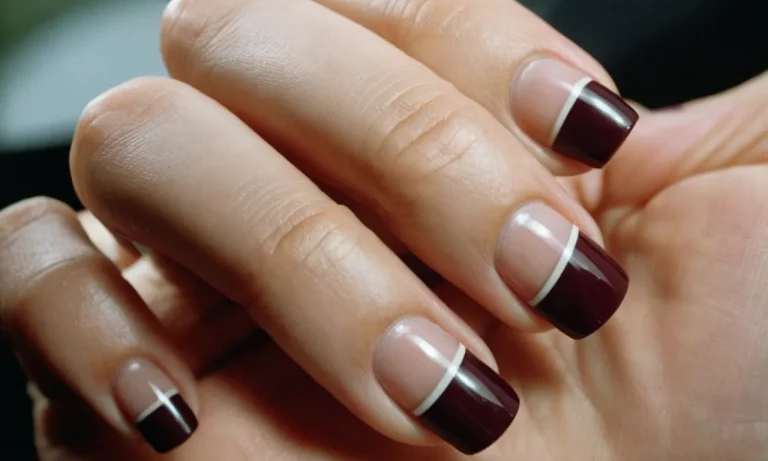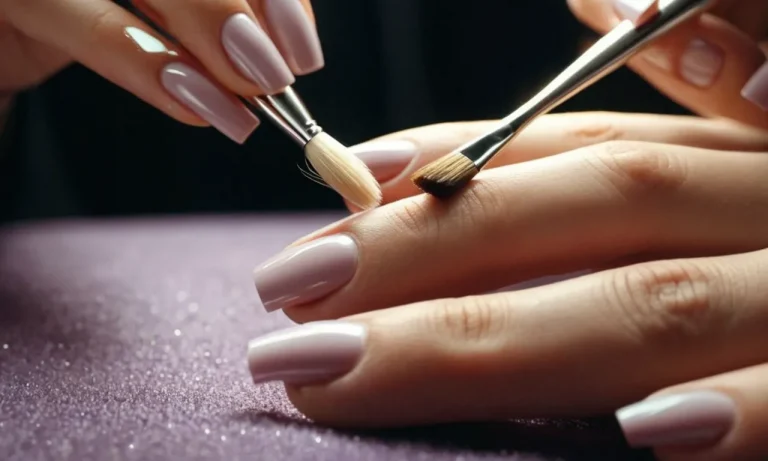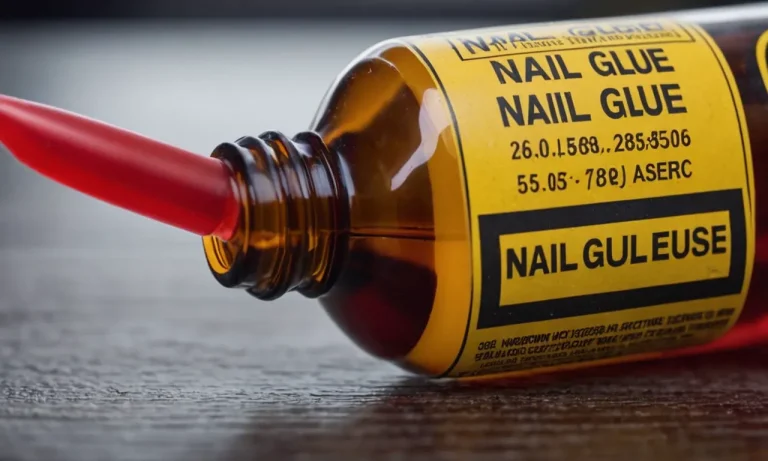Infected Toe After Nail Removal: Causes, Symptoms And Treatments
Having an ingrown toenail removed can provide welcome relief from pain and discomfort. However, in some cases, an infection may develop afterwards. This can result in redness, swelling, drainage, fever, and other problematic symptoms.
If you’re short on time, here’s a quick answer to your question: An infected toe after nail removal is usually caused by bacteria entering the open wound. Common symptoms include redness, swelling, drainage, pain, fever and foul odor.
Treatment involves keeping the area clean and dry, antibiotics if prescribed by your doctor, and over-the-counter pain medication.
What Causes an Infection After Nail Removal?
Bacteria Entering the Open Wound
One of the main causes of infection after nail removal is bacteria entering the open wound left behind. When a toenail is removed, it leaves behind an open sore that is vulnerable to bacteria. Even with proper bandaging, bacteria from the surrounding skin, shoe, sock or environment can get into the wound and cause an infection.
Some common bacteria that infect toenails are staphylococcus, streptococcus and pseudomonas species.
An infection can occur if proper sterilization of tools was not done prior to the nail removal procedure. Bacteria from unsterilized tools can get directly into the open wound and start an infection. Using contaminated water to clean the foot after nail removal can also introduce bacteria into the wound.
People with diabetes, poor circulation or a weakened immune system are at higher risk of developing an infection after nail removal. Their body’s defenses are down, making it easier for bacteria to proliferate.
Not Properly Caring for the Wound
Lack of proper wound care after nail removal is another common cause of bacterial infection. The open wound needs to be kept clean and protected with a sterile bandage until fully healed. If the bandage gets wet or dirty, it provides an excellent place for bacteria to grow.
Not changing the bandage frequently enough, like once a day, also increases infection risk. The warm, moist environment under the bandage allows bacteria to thrive. Failing to keep the wound area dry can have the same effect.
If ointments used on the wound area are not sterile, they can introduce bacteria. Using fingers instead of gauze to apply ointment adds more bacteria. Picking at scabs or debriding new skin growth prolongs wound healing and opens the door to bacteria.
Soaking the foot too soon after nail removal can get the wound wet and unprotected. The warm, moist soak water can harbor bacteria. Even shower water on an unbandaged wound can lead to infection.
Skipping post-care appointments prevents the doctor from monitoring the wound for signs of infection like redness, swelling, oozing and pain. Early treatment is key to curing infections before they spread deeper or throughout the body.
Signs and Symptoms of Infection
Redness and Swelling
One of the most common signs of an infected toe after nail removal is redness and swelling around the toe. This occurs as your body sends increased blood flow to the area to fight off the infection, resulting in inflammation. The redness may start out subtle but quickly spread and intensify.
Swelling in the toe and surrounding area also tends to progressively worsen if left untreated.
Drainage
An infected toe often produces drainage, which could be purulent (containing pus) or clear and watery. Pus is a sure sign the infection is bacterial and needs antibiotic treatment. However, even clear drainage may indicate the wound has become infected. The drainage may have a foul smell as well.
Pain
Most people have some degree of pain after nail removal surgery. However, worsening pain that seems disproportionate to the procedure may indicate an infection. It may be a throbbing, sharp or burning pain. The pain typically gets worse over time rather than improving.
Fever
While less common than other symptoms, a low-grade fever (under 102°F/39°C) sometimes accompanies an infected toe. This occurs as cytokines released by inflammatory cells alter the hypothalamus’ temperature set-point.
The fever indicates your body is mounting an immune response to fight the infection.
Foul Odor
Finally, a foul or putrid odor emanating from the toe strongly suggests infection. This is caused by microbes breaking down skin and tissue, releasing smelly chemical byproducts. The odor tends to worsen over time if the infection goes untreated.
It’s important to seek medical care if you notice any foul smells coming from your toe region after surgery.
Treatment Options
Keep the Area Clean and Dry
Keeping the affected area clean and dry is crucial for preventing infection and allowing proper healing after toenail removal. Here are some tips:
- Wash your hands thoroughly before and after caring for the toe to prevent bacteria transfer.
- Gently cleanse the area daily with mild soap and water. Be sure to dry it completely after.
- Apply antibiotic ointment and loosely cover with a bandage. Change the bandage daily.
- Wear clean, dry socks. Avoid tight shoes that could irritate the area.
- Elevate your foot when possible to reduce swelling and discomfort.
- Avoid soaking the toe in water until it has fully healed to prevent infection.
Continuing proper wound care at home is vital for fast healing without complications. Contact your doctor if you notice increasing pain, redness, swelling, foul odor, or fever as those may indicate infection.
Antibiotics
Your doctor may prescribe oral or topical antibiotics if your toe shows signs of infection after nail removal. Antibiotics work by killing harmful bacterial or fungal infections invading the wound site. Some common options include:
- Oral medications like Augmentin, cephalexin, or clindamycin.
- Topical ointments containing neomycin or bacitracin to apply directly on the affected toe.
- For stubborn fungal infections, oral Lamisil or topical Lotrimin cream.
Take any prescribed antibiotics fully as directed. Using antibiotics properly is key to eliminating infections. Typical treatment lasts 7-10 days but can extend longer for more serious infections. Call your doctor if symptoms don’t start improving within a few days of starting antibiotics.
Over-the-Counter Pain Medication
It’s common to have pain, swelling, and inflammation after toenail removal. Over-the-counter medications can help provide relief:
- Acetaminophen (Tylenol) reduces pain and fever.
- NSAIDs like ibuprofen (Advil) or naproxen (Aleve) ease pain and inflammation.
- Aspirin also calms pain, but may increase bleeding risk.
When using OTC meds, carefully follow package instructions regarding dosage and frequency. Taking too much can lead to serious health issues. If pain persists more than 1 week post-procedure, contact your podiatrist.
Here is an overview of expected pain levels during the healing process:
| Days 1-3 | Moderate pain |
| Days 3-7 | Mild dull pain |
| 1-2 weeks | Very mild or no pain |
See your doctor promptly if you have severe or worsening pain as that may require treatment for complications like infection.
When to See a Doctor
Fever Over 100°F (38°C)
A fever is a key sign that an infection may be developing after toenail removal surgery. Fever indicates your body is mounting an inflammatory response to fight infection. If your temperature rises above 100°F (38°C), contact your doctor right away.
Left untreated, infections can spread from the toe into deeper tissues and the bloodstream, so prompt medical care is essential.
Increased Redness, Swelling, Pain
It’s normal to have some redness, swelling, and soreness after toenail removal, but these symptoms should steadily improve over several days. Worsening redness, swelling, or pain can signal an emerging infection or other complication.
Don’t hesitate to call your doctor if your toe becomes significantly more reddened, swollen, or tender, as antibiotics or other treatment may be needed.
No Improvement After a Few Days
If your toe is still extremely painful, swollen, or inflamed after 3-5 days, it’s wise to have your doctor assess the situation. Lingering postoperative inflammation can sometimes happen due to slow healing, but it may also be caused by infection, poor circulation, or other issues requiring medical care.
Getting an expert opinion is important to determine if any treatment is needed to help you recover properly.
In most cases, complications after toenail removal are minor and easily resolved with proper care. However, it’s crucial to watch closely for any signs of trouble and promptly consult your doctor about bothersome or worsening symptoms.
Prompt treatment of infections and other problems leads to much better outcomes. Don’t hesitate to call for advice if your recovery seems to be taking a turn for the worse after a few days.
Prevention Tips
Follow Post-Surgery Instructions Carefully
It is crucial to closely follow all post-surgery care instructions provided by your podiatrist to prevent infection and ensure proper healing after nail removal surgery. Some key prevention tips include:
- Keep the wound dressing clean and dry according to your podiatrist’s directions, usually 24-48 hours.
- Elevate your feet to minimize swelling and throbbing.
- Take prescribed antibiotics and pain medications as directed.
- Wear open-toed shoes or sandals to avoid pressure on the wound.
- Schedule follow-up appointments so your podiatrist can monitor the healing.
According to authoritative medical sites like American Orthopaedic Foot & Ankle Society, following post-op guidelines can greatly lower risks of infections that lead to more serious toe complications.
Keep Dressings Clean and Dry
Keeping your wound dressings clean and dry is vital to prevent bacteria from entering the nail bed and causing infected toes. Here are some tips:
- Wash hands thoroughly before changing bandages.
- Gently cleanse the site daily with mild soap and water.
- Apply antibiotic ointment if prescribed.
- Re-cover with clean bandage.
- Keep feet dry by avoiding direct contact with water until healed.
Do not soak feet to prevent bacteria from entering the open nail bed. Water can also loosen dressings. If dressings do get wet or dirty, replace them immediately. Research shows that good wound care and hygiene can reduce surgical site infections by more than 50%.
Watch for Signs of Infection
It is important to monitor the surgery site for any symptoms that may indicate an infected toe. Contact your podiatrist promptly if you notice:
- Increasing pain or throbbing
- Swelling and redness
- Drainage, bleeding, or foul odor
- Warm skin around the wound
- Fever over 100°F/37°C
According to the American Podiatric Medical Association, prompt treatment of infections improves outcomes and prevents complications like cellulitis or osteomyelitis that could require hospitalization or additional surgeries.
| Uninfected Wounds | Infected Wounds |
|---|---|
| Minimal discomfort | Increasing pain |
| No fever | Fever >100°F/37°C |
| Closed incision | Oozing, bleeding |
| No odor | Foul odor |
Being attentive by watching for infection warning signs can help patients get timely treatment for infected toes.
Conclusion
While an infected toe after nail removal can be frustrating and painful, it is often easily treatable with proper care. Keeping the wound clean and dry is key, along with taking any prescribed antibiotics. Over-the-counter pain medication can also help provide relief while healing.
If symptoms persist or worsen, promptly follow up with your doctor for evaluation and treatment guidance. With the right care, your toe should be back to normal soon.







